Montreal's Notre Dame
The main altar in the basilica.
“So, this isn’t a copy of the Notre Dame in Paris?” A tourist with a camera phone pointed up for a long panorama of the ceiling quizzed a nearby tour guide.
“No, it’s not,” the tour guide replied casually, as if she had heard the question often. We had just finished the tour of the Notre-Dame Basilica of Montréal and the guide was standing in the central nave fielding questions while incense wafted from countless votive candles and heavy thuribles under ornate wood trim.
Votive candles.
“So there’s not that big stained glass window like in Paris?” the same tourist persisted, examining the stained glass windows between the candlelit bye-altars.
“No, not like the rose window.”
“Why not? I mean, it’s just stained glass.”
The basilica has several rose windows in the ceiling for ambient light, but they are not copies of the famous rose window in Paris.
The tour guide sighed. “No. First, do you have any idea how expensive stained glass like that is? The congregation couldn’t afford it. Second, the only place you could put a window like that is behind the altar. And this church faces full east. In fact, there used to be a window on that wall, but the sun would blind the congregation when they came in for Mass. So when they decorated the interior they got rid of the window and put in the present altar.”
“Oh,” my fellow tourist said, and then, “How big is this cathedral again?”
“It is 60 meters, or 200 feet tall, and 79 meters, or 259 feet long. But remember, it’s not a cathedral, it’s a basilica. You can have as many basilicas as you have churches in a city, but you can only have one cathedral because that’s where the archbishop is.”
The basilica has an impressive interior.
I wondered where the archbishop for the Montréal area was based. A quick Google search later that afternoon told me that was Cathedral-Basilica of Notre-Dame de Québec in Québec City, a two and a half hour drive from Montréal.
“So what makes a church a basilica?” another tourist asked.
The facade of the basilica.
“It is a church designated by the Vatican to have architectural, artistic, and historical value.”
The tour guide had explained this already on the tour, shortly after describing the history of the church from its humble beginnings as a Jesuit-run wooden chapel in 1642, until the Sulpicians (whom the guide explained were similar to the Dominicans) took over in 1657 and built a chapel adjacent to the Hôtel-Dieu, the first hospital of Montréal (then just a town called Fort Ville-Marie). Construction of the stone church finished in 1683, and that church fed the spiritual needs of the neighborhood well into the 1800s, despite overcrowding to the point that parishioners frequently had to listen to Mass from the parvis, or enclosed portico of the church. In 1823 construction for the new church was approved.
The tour guide had spent some time describing the architect for the new church, James O’Donnell, an Irish Protestant from New York. Despite having several talented architects in Montréal, none of these architects had any experience building a church of the planned scale. O’Donnell had just finished the Christ Church in Manhattan and First Presbyterian in Rochester and was put in charge of everything related to the Montréal project.
“Including the budget, quite unfortunately,” the tour guide noted. “Within two years he blew the budget and so the church was finished without the towers or internal decor.”
Place d'Armes with the monument honoring Paul de Chomedey, Sieur de Maisonneuve who was a French military officer and founder of Montreal.
O’Donnell died of pneumonia in 1830, shortly after the main construction of the church was finished. On his deathbed he converted to Catholicism so he could be buried under the church. While he is the only person officially buried in the church’s crypt, the tour guide assured us that many more bodies were entombed under the stone since the basilica was built just behind the original stone church on top of the original cemetery (the current cemetery is now on Mont Royal). The original church, which stood directly in Rue Notre-Dame, was demolished with just an outline of stones left to mark where it once stood on the edge of Place D’Armes, the old plaza where military events were once staged.
“The bell towers were finished over ten years later,” the tour guide explained, “by architect John Ostell according to O’Donnell’s plans.” I heard the bells ring the eleven o’clock hour later that morning while I explored the plaza: the massive “Jean-Baptiste” bell (also called ‘Le Gros Bourdon’ or ‘The Large Bumblebee’), cast in England and weighing 24,000 pounds (11 tons), hangs quietly in the western tower called La Persévérance (Perseverance) and is only rung on special occasions, while a carillon of 10 bells hangs in the eastern tower, called La Tempérance (Temperance).
“The interior decor was completed much later,” the tour guide explained, “and at best can be described as ‘eclectic.’ The interior, with the blue painted and starry ceiling, was done by Victor Bourgeon and Curé Victor Rousselot, and was based on the Sainte-Chapelle in Paris. The altar, along with the architecture, was designed in the Neo-Gothic style, and the ornate columns were inspired by Byzantine decor.”
I suppose this Paris reference may have tripped up my fellow traveler with thoughts of various Notre-Dames and bells and hunchbacks. I, for one, had a notebook full of deplorable phonetic spellings that needed thorough fact-checking after the tour, though I never found mention of Byzantine inspired style in the Notre-Dame de Montréal on any of my online resources.
Stained glass depicting religious history of Montreal.
“The stained glass,” the tour guide continued, “is particularly unusual, since it depicts the religious history of Montréal rather than biblical scenes.”
It was striking to see these stained glass windows, particularly the images of Saint Marguerite Bourgeoys and the native Iroquois. I never heard the full story that is depicted in the glass, but a slow procession along the walls provides a generally good idea of Montréal’s religious history from French fortress outpost for fur trading to the uncloistered community of service-dedicated women to the construction of the current church. This personalized touch gave the large basilica a closer sort of intimacy, further emphasized by the intricate and warm woodwork in the basilica. The polychrome decorations of the railings, columns, and trim are all sculpted wood, as are many of the sculptures along the walls. This provides a sense of something very local, something well-grounded in Montreal itself. The high ceilings and hand-hewn linden altar depicting the Eucharist speak of the Catholic Church’s commanding presence, but the carefully crafted woodwork and paintings - of Saint Marguerite Bourgeoys and Saint Marie-Marguerite d’Youville and others - tightly fastens the Church to the community.
Wood statue of Saint Marie-Marguerite d’Youville
But this extensive use of wood is nothing compared to what is in the Chapel of Notre-Dame du Sacré-Cœr (‘Sacred Heart’), an addition behind the main altar. Built between 1888 and 1891, and then rebuilt between 1979 and 1982 after an arson in 1978, the chapel is a stunning display of warm linden wood and bronze. Here the term ‘eclectic’ is appropriate for the decor. While the amount of wood trim in the main nave was surprising (especially with real flame candle offerings instead of electronic votives), the wood-finished chapel is astonishing, but also inviting. After the fire the lower level of the chapel was restored, but the upper level was reworked in contemporary style, an uncommon sight in traditional Catholic churches. The modern bronze altarpiece was commissioned to Charles Daudelin, and its 32 bronze panels together measure 5 meters (16 feet) wide and 8 meters (26 feet) high, and weigh 20 tons. The altarpiece depicts humankind’s march to God through the difficult stages of life. The chapel, facing east, fills deliciously with bright natural light that crowns the bronze altar, glows off the linden wood, and kisses the pipes of the contemporary organ.
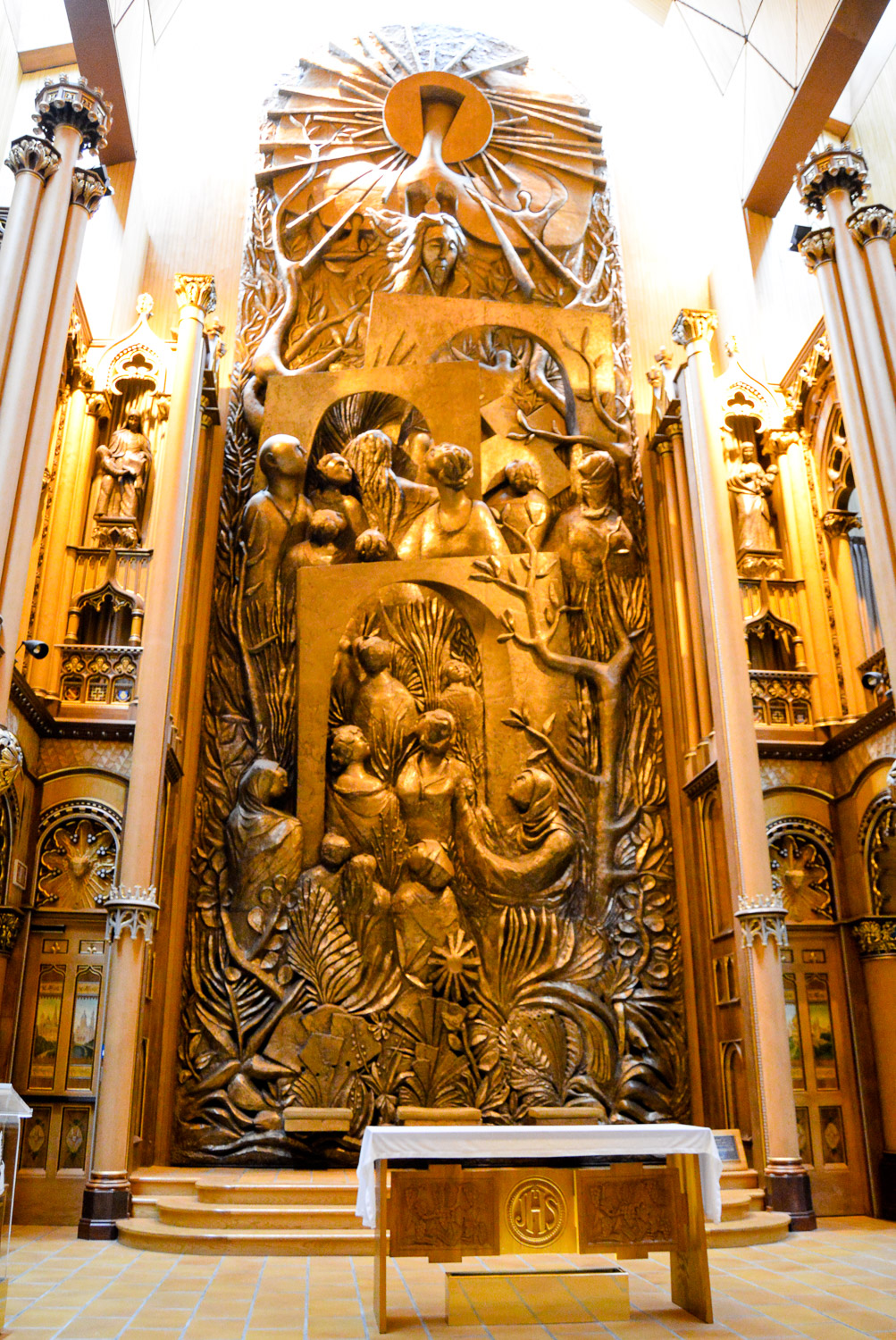
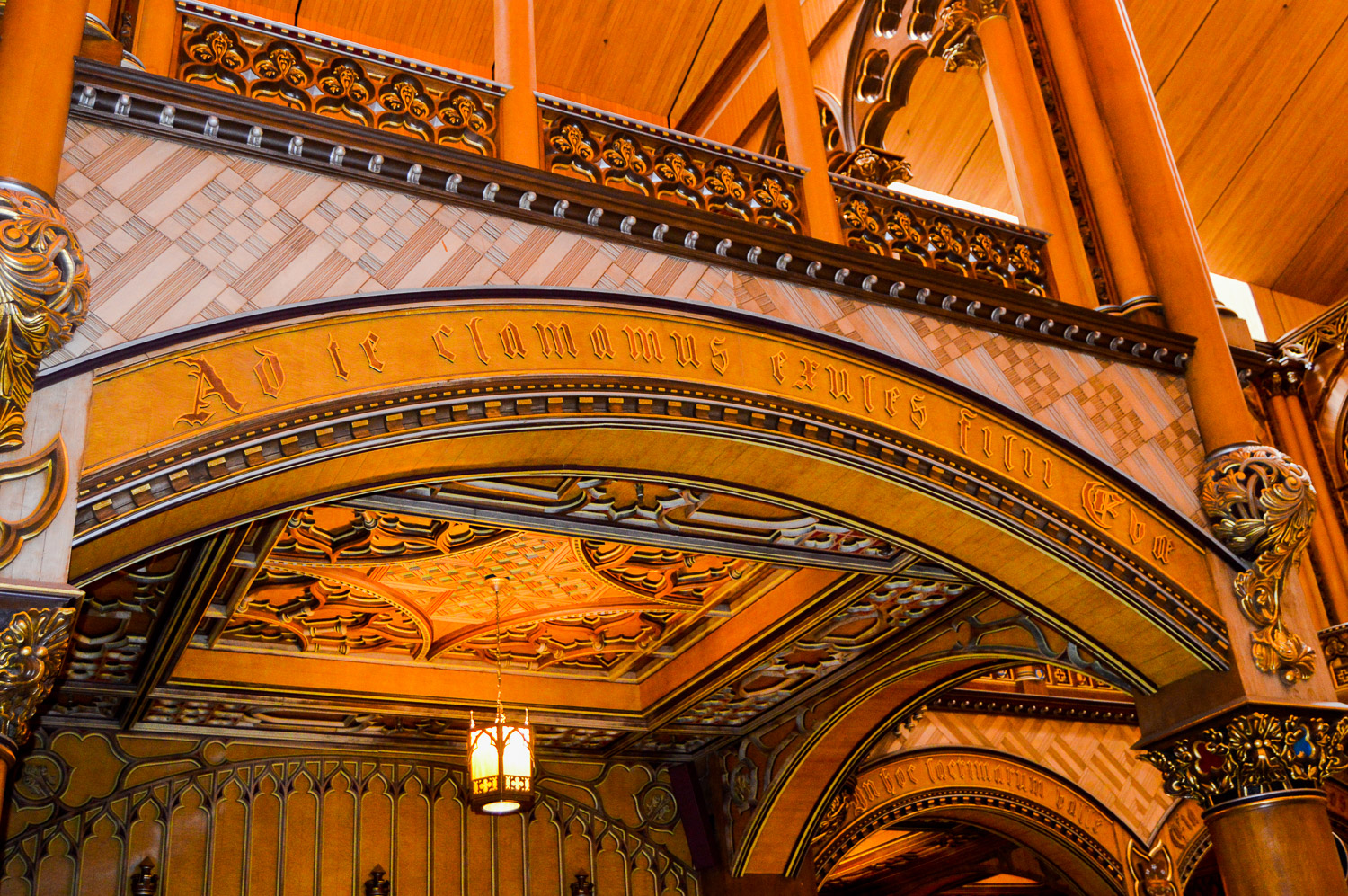
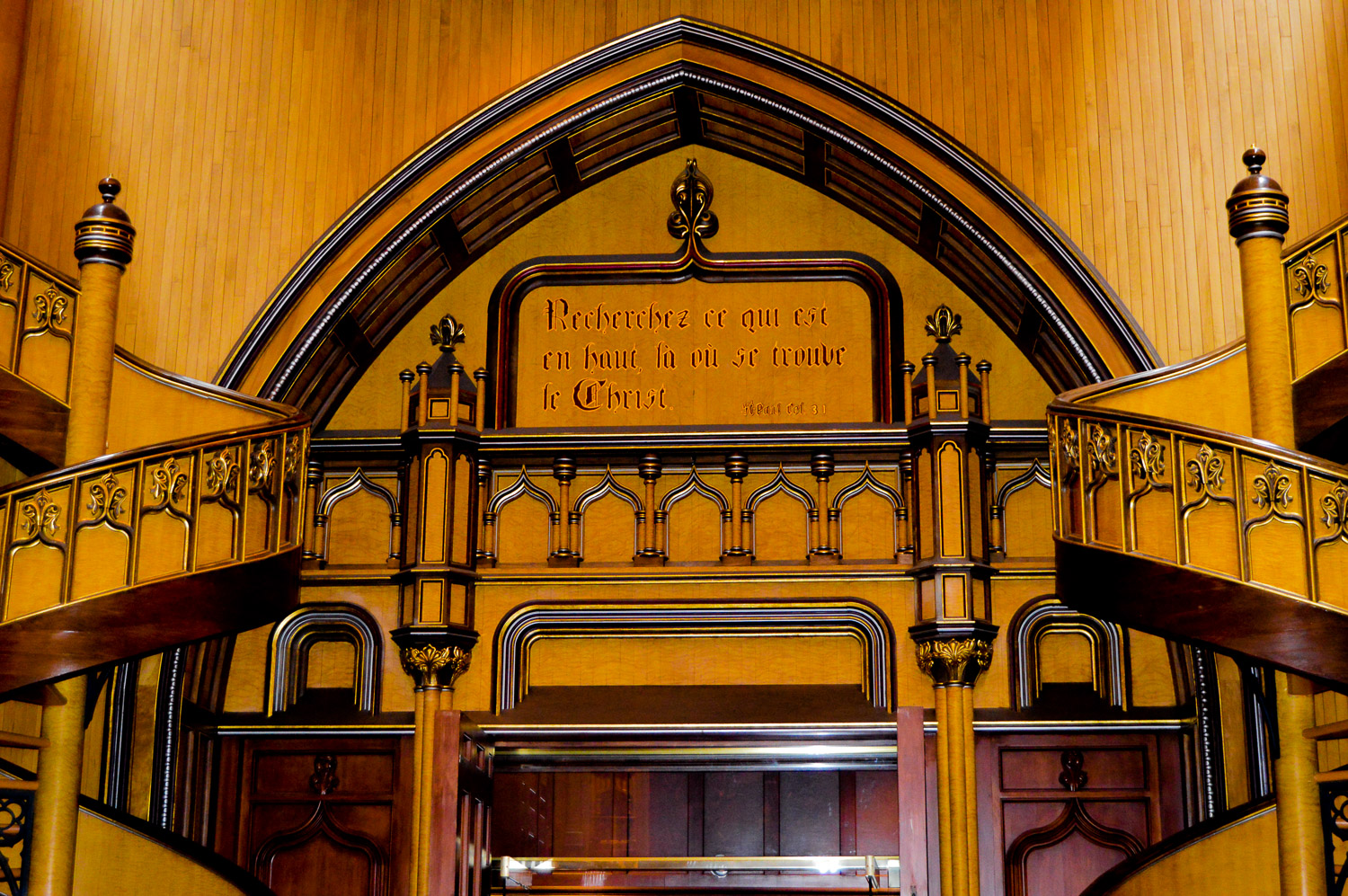
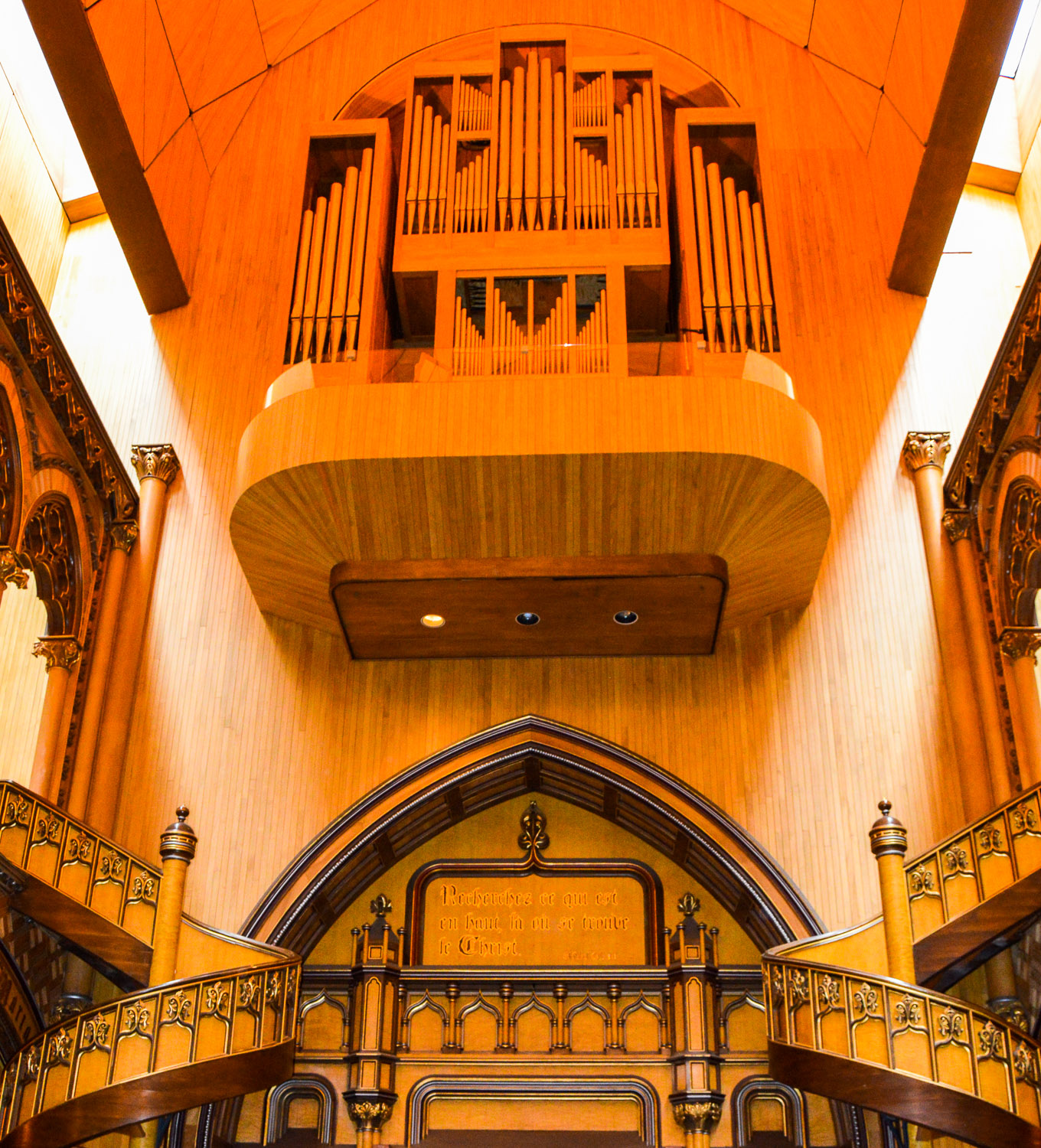
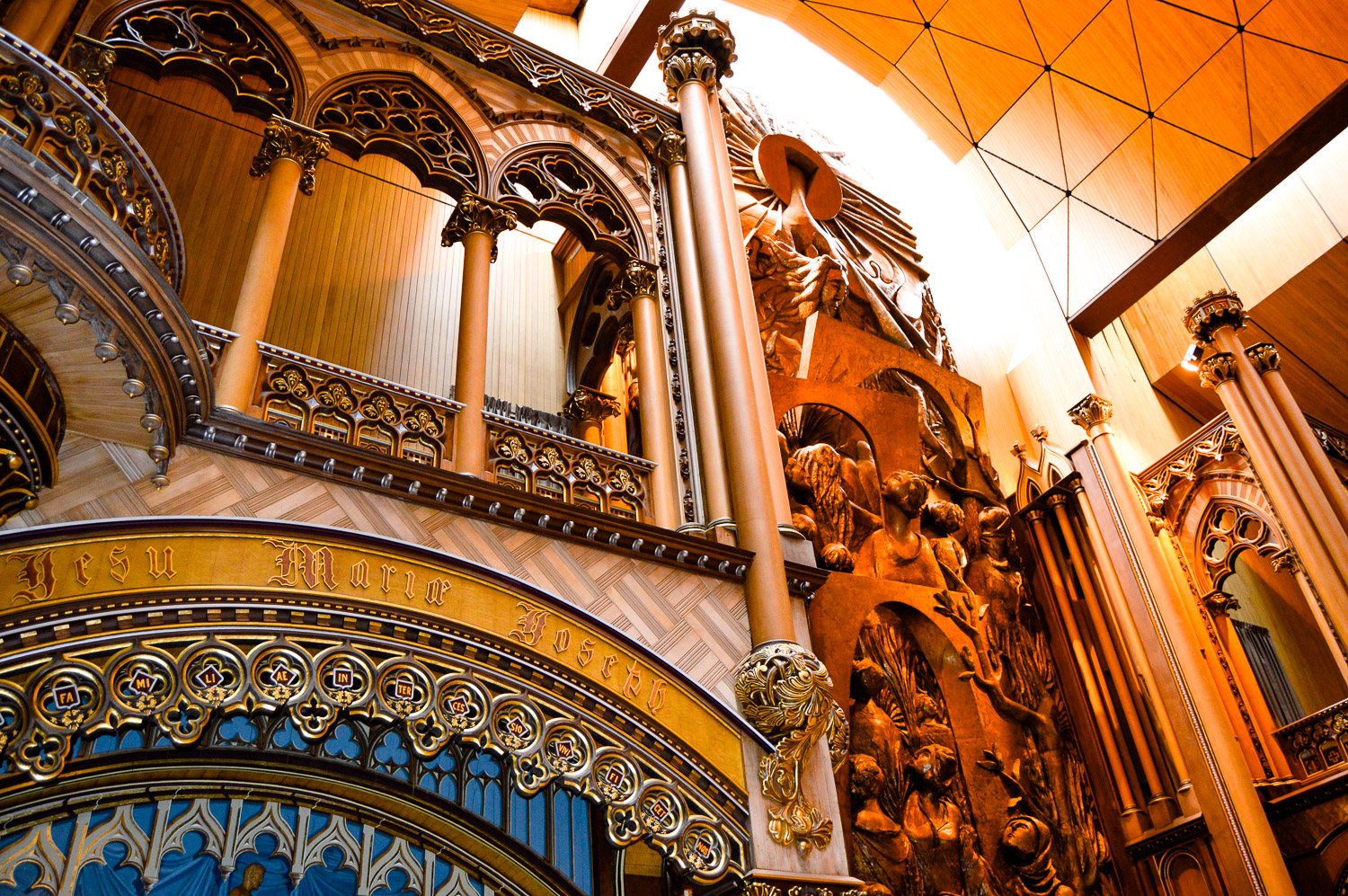
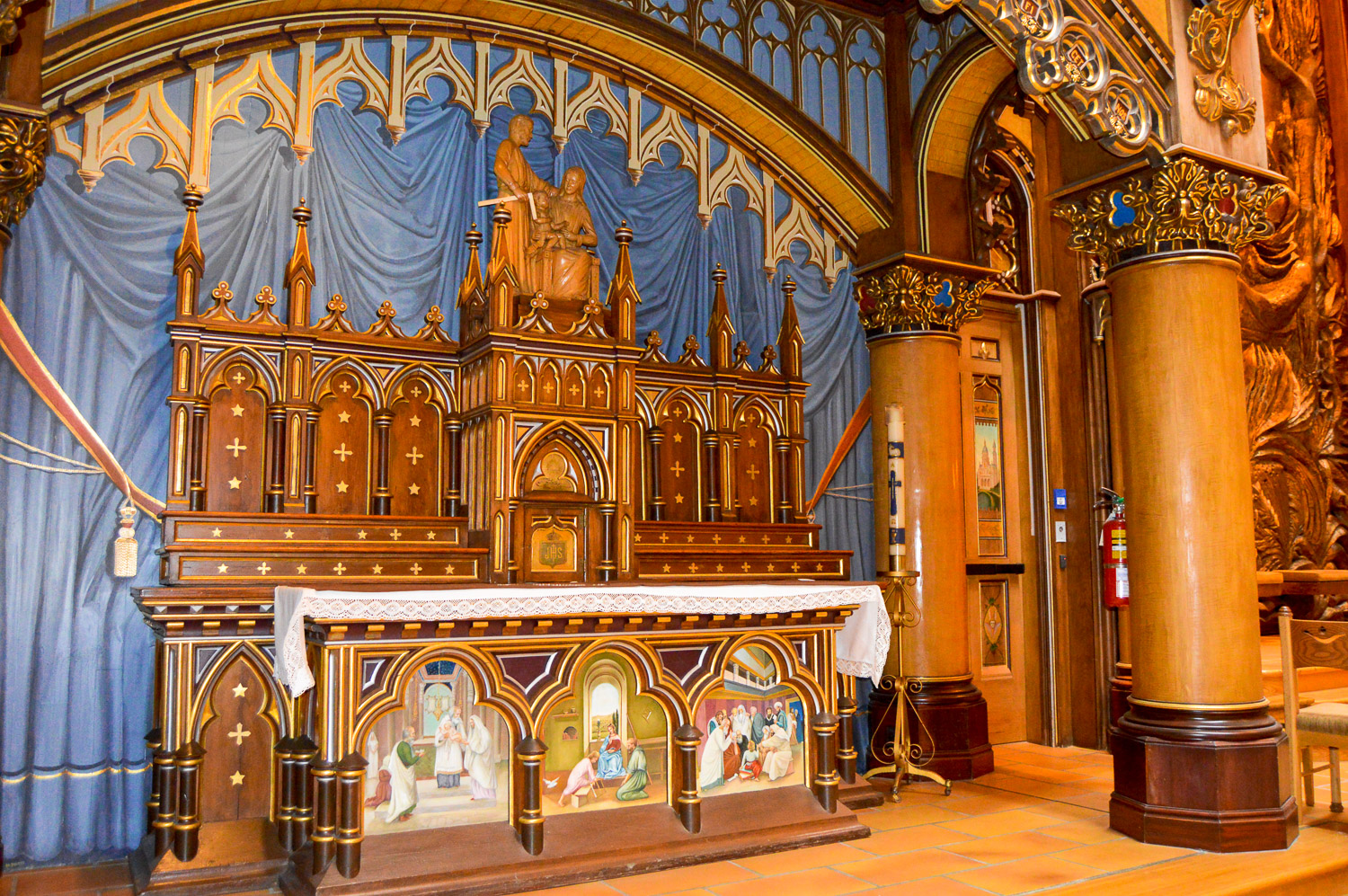

The guide briefly described the chapel’s organ, and gave more detail on the behemoth organ of the basilica. The Casavant Fréres pipe organ was built in 1891, and upon its 100th anniversary received a restoration that brought its total number of pipes to 7,000 ranging from 6 millimeters (1/4 inch) to 10 meters (32 feet) long. “If you get a chance,” the tour guide urged us, “check the schedule and come listen to the organ. It’s usually played at weekend Mass.”
The Casavant Fréres pipe organ
Unfortunately we only had a couple days in Montreal and would not be able to attend Mass at the Basilique Notre-Dame de Montréal, but it’s certainly a church that, if time and interest permits, warrants a deeper look, even if you’re just searching for a glimpse into Montreal’s storied past.
Source: http://www.basiliquenddm.org/en/
Tourists take a last long look at the inside of the basilica.

